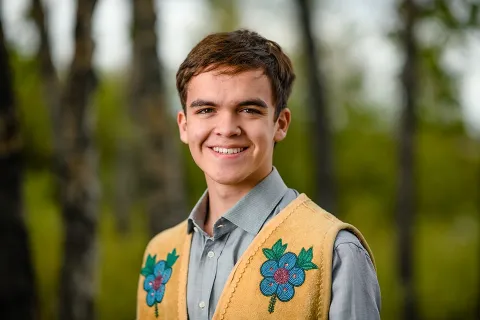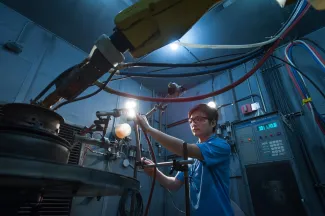"There are significant opportunities for Indigenous students who want to pursue a career in engineering or other STEM fields."

Graham MacDonald
- Degree:
- Bachelor of Applied Science
- Program:
- Campus: Vancouver
- Year: Going into 2nd year (as of July 2023)
Why did you want to study engineering?
I’ve always known I wanted to do engineering. As a baby, one of the first words I said after ‘mom’ and ‘dad’ was ‘airplane.’ I must have seen one flying overhead and thought it was really cool – and this is the sort of stuff that has interested me ever since.
How did you choose your specialization in Materials Engineering?
Although there are a lot of advances happening in engineering, the materials we can make things out of are limiting our progress in many areas.
Being able to expand those horizons is something you can do as a materials engineer. You can identify what the right materials might be to solve a problem, assess the properties of those materials that matter and address bottlenecks in production.
Sustainable resource extraction, energy storage and composites are among the generation-defining problems that will keep materials engineers employed for the foreseeable future and are areas where UBC hosts considerable industry-leading expertise.
To archeologists, periods of our history are defined by the materials of our implements: be it stone, iron or bronze. Our age, an information age, has been defined through an ever-increasing mastery of silicon. Now that the limits of silicon are in sight, the door is open for innovators and their materials to lead the charge. I applied to MTRL because I knew whatever specialty I ended up focusing on, there is an abundance of problems to satisfy my curiosity.
Have you had a co-op or other work experience position?
This summer I am working at MDA as a Systems Engineering Intern writing code that will automatically evaluate the performance of WildfireSAT, a mission that will measure the intensity of wildfires and will provide firefighters with the data that they need to meet the challenges of climate change.
Any advice for students considering engineering?
One thing I learned was the importance of finding ways to relate your learning to something that matters to you.
If you can do that, it’s a lot easier to be motivated to learn and increase your understanding.
The Truth and Reconciliation Commission called on the federal government and by extension all Canadians to close the gap in Indigenous post-secondary education in a single generation. Despite a situation where all the systemic problems are with the Canadian government, it does not mean that we cannot be a part of the solution. This call to action was as much a call on Indigenous youth as it was on the federal government. For those that can, we have not just an opportunity, but a duty to pursue higher education. If we want to ensure that the toiling of our ancestors was not in vain, we must continue their march.
Finally, there’s a lot of emphasis on Indigenization right now in Canada. It’s become a priority. Many companies are starving for Indigenous talent because most organizations receiving federal funding have quotas for Indigenous procurement, which means that they need to hire Indigenous people to remain competitive. However, because of a century of misguided federal policy, most technical fields do not have enough Indigenous people to meet the requirements, which provides an outsized opportunity for Indigenous people entering the STEM workforce. This means there are significant opportunities for Indigenous students who want to pursue a career in engineering or other STEM fields.




